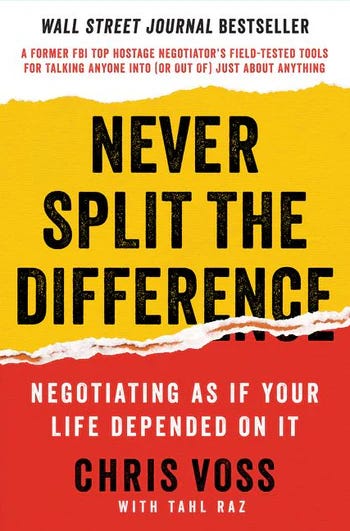Master high-stakes negotiation
A former FBI hostage negotiator and author of ‘Never Split the Difference’ helps transform your conversations and negotiations.
Key Points:
Negotiation isn’t about convincing; it’s about understanding.
People feel safer when they’re in control, even if that control simply means they have the ability to say no.
Life is negotiation.
Never Split the Difference: Negotiating As If Your Life Depended On It
By Chris Voss and Tahl Raz
Grade: 99
Visitors to my home office are greeted by walls lined with books overflowing from the shelves they’re housed on. They often notice a recurring theme, too.
“Why do you have multiple copies of the same book?” I’m occasionally asked.
The answer: Some books are so good that I cannot resist buying them over and over. Chris Voss’s Never Split the Difference is such a book. Without question, it is one of the most impressive, most illuminating, and most helpful books I’ve ever read. (I’ve read it at least three times.) Voss, a former FBI hostage negotiator, uses the book to share actionable advice from his real-life experiences. Lucky for readers, that advice can transform the way they negotiate, especially in high stakes, stressful situations. But the advice is just as useful in all areas of life, whether in business, family, or everyday life.
Simple but effective examples you can put to immediate use
The first time I read the book, I was blown away at Voss’s experiences in the field, especially in hostage negotiations, and how he easily applied what happened in the field to what we experience each day. There is no better way to convey his teachings than to share his examples, advice, and rationale:
Tactical empathy: refers to using deep listening to build rapport.
By listening actively and acknowledging the other person’s position, negotiators can gain influence, he says. He shares the experience of being involved in a tense hostage standoff. Instead of asserting demands, he listened and repeated the hostage-taker’s words back to him, which he refers to as “mirroring.”
“Negotiation is not about convincing; it’s about understanding.”
Ultimately, he was able to deescalate the tension and save lives.
Be a Mirror: With mirroring, the author repeats a few key words shared by the opponent. This can make the person feel understood and respected.
“Mirroring is the art of insinuating yourself into someone’s world.” It’s a deceptively simple technique that allows you to build trust and gently guide the conversation.
Say you’re meeting with a dissatisfied client. He or she might say “I’m just not seeing the value here.” By mirroring, you repeat back to them, “not seeing the value?” This, he says, invites them to elaborate, often leading to valuable insights into their expectations and concerns.
As someone who manages clients with disparate needs and goals, I found this advice valuable. It has been put to use several times, always successfully. (Thanks, Chris.)
Don’t feel their pain. Label it. This was another of my favorite parts of the book. Voss’s technique entails labeling emotions to validate the other party’s feelings. For example, by saying “It sounds like you’re feeling frustrated” helps the other person feel seen. This—and I can speak from experience here—can be amazing for de-escalation during difficult conversations.
“Labeling emotions pulls pain from the shadows,” Voss writes.
He uses the example of conflict arising among team members.
“I feel overworked and unappreciated,” responding with, “It sounds like you’re feeling undervalued,” demonstrates empathy, making resolution easier to reach.
Beware of “yes”: This section was one of the most surprising. In it Voss argues that “yes” is often meaningless in negotiation since people tend to say it to end a conversation, not commit to a solution. He instead encourages getting the other party to say “no”—you read that correctly. This, he says, can, paradoxically, lead to more open communication.
“People feel safer when they’re in control, even if that control is just the ability to say no.”
He shares a compelling example involving contract negotiations. Instead of asking, “Do you agree with these terms?” Voss says to ask “Is there anything here that doesn’t work for you?” This shift gives the other person control and can lead to clearer insights into their true priorities.
Wait to hear “that’s right”: This part of the book was to most intuitive, but not for obvious reasons. I knew the words were important, but not as important as Voss made them appear. He says someone who says “that’s right” has just assured you of their genuine agreement and understanding. In fact, those two words are more important than “yes” because they reflect the other person’s beliefs.
In a salary negotiation, he says, instead of saying, “I think I deserve a raise,” reframe it to align with the company’s values, by leading with “If I’m hearing correctly, you want someone who’s committed to growth here” to get the most satisfactory answer for both parties: “That’s right.”
Such an approach reinforces mutual goals, helping both parties feel aligned.
Why you should read the book
I hope I’ve convinced you to read Never Split the Difference. After reading and learning from it, you’ll be a more confident negotiator in all areas of your life.




